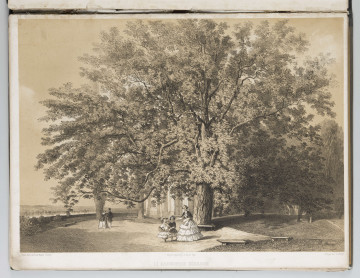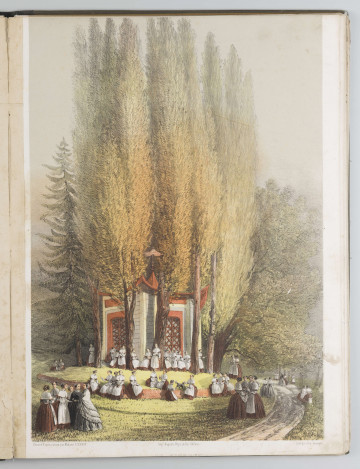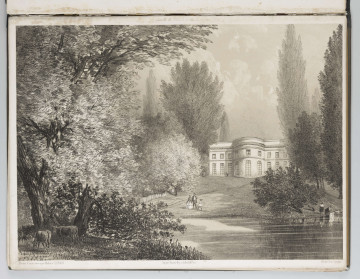
Le marronnier seculaire
1860
National Museum in Lublin
Part of the collection: Lubliniana. Painting views of Lublin and the Lublin Region
The arcaded bridge over the "gorge" leading to the Greek House, built as an orangery, is still a picturesque corner of the eastern part of the Czartoryski Park in Puławy. The prominent antique pediment of the building was a monumental vestibule to the actual, former garden orangery (it was one of five orangeries erected within the palace-park complex). It was built between 1788 and 1791, probably to a design by Christian Piotr Aigner. Behind the classicist, four-column Doric portico, there was a semicircular room, called the arbour, where small sofas were once placed, allowing for a moment's respite or social gatherings in Princess Isabella's beloved plant kingdom. Above the entrance to the arbour there is an inscription taken from Virgil: HIC OMNES ARBUSTA IUVANT HUMILESQUE MYRICAE (A grove and low tamarisks delight everyone here). Behind the arbour there was a proper orangery with a sloping, glazed south wall.
Next to the garden pavilion was a statue of Venere, and a spring flowed from the stone wall. In 1875, according to Bolesław Prus: "At the end of the avenue with overhanging members, a white edifice can be seen, decorated with a statue of some young man in classical negligee".
The bridge over Głęboka Street (today also called the Bridge of Lovers) dates from 1788-1800. Brick, plastered, single-span, from the side of the park, it is provided with a decorative element - a portal gate shaped in the form of an arch, called the Gothic gate. Stairs with railings lead to the bridge. The construction of the bridge is located between the retaining walls made of brick wall of the pit (called the Głęboka Street or the Dolna Road, leading from Puławy to Kazimierz; later it was the former Głęboka Street).
The motif of the bridge with the old walls of Głęboka Droga and the portico of the former orangery, picturesquely closing the perspective of the park avenue, was immortalised by the greatest Polish artists, among them Zygmunt Vogel in 1796 and Aleksander Gierymski before 1886.
Renata Bartnik
Author / creator
Dimensions
cały obiekt: height: 42,8 cm, width: 29,9 cm
Object type
graphics
Technique
lithography
Material
cardboard
Creation time / dating
Creation / finding place
Owner
The National Museum in Lublin
Identification number
Location / status

1860
National Museum in Lublin

1860
National Museum in Lublin

1860
National Museum in Lublin
DISCOVER this TOPIC
National Museum in Lublin
DISCOVER this PATH
Educational path